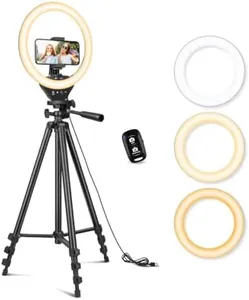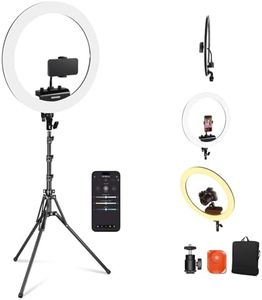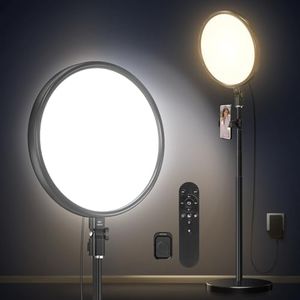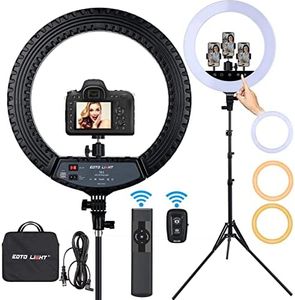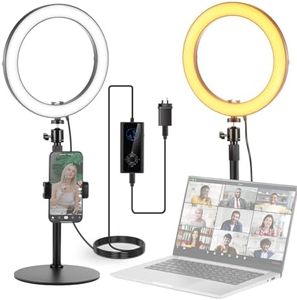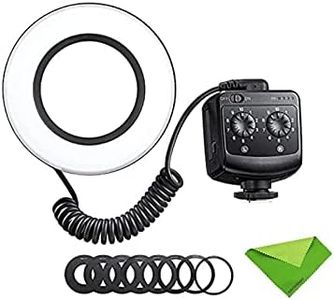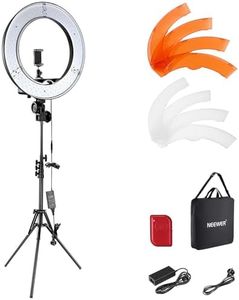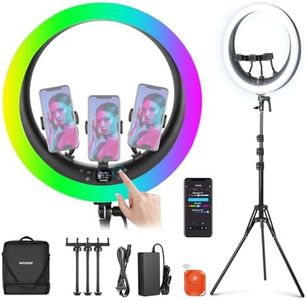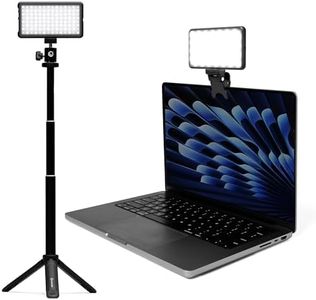We Use CookiesWe use cookies to enhance the security, performance,
functionality and for analytical and promotional activities. By continuing to browse this site you
are agreeing to our privacy policy
10 Best Ring Lights
From leading brands and best sellers available on the web.Buying Guide for the Best Ring Lights
When choosing a ring light, it's important to match the product to your specific needs, whether it's for photography, video calls, makeup, or content creation. A ring light can enhance your appearance by providing even and flattering illumination, but with so many options on the market, understanding the key specifications will help you select the best fit for your situation. Think about where, how, and for what purpose you'll use the ring light, and use that as your guide.Diameter/SizeThe diameter of a ring light refers to its overall size, which affects how much light it produces and how broadly it's distributed. Smaller lights (typically 6-10 inches) are handy for close-up work like webcam calls or makeup, where you don’t need to light up a large area. Medium-sized options (10-14 inches) strike a balance, suitable for desk setups or small rooms. Larger sizes (14 inches and above) can illuminate wider scenes, making them ideal for photography or filming in bigger spaces. If you mainly use your ring light for portraits, makeup, or streaming from a desk, a medium size is often practical; for full-body shots or group scenes, consider a larger one.
BrightnessBrightness indicates how much light the ring light can emit and is often measured in lumens. Some lights have adjustable brightness, letting you set it low for a softer effect or higher to light up the whole area. Low-brightness settings (under 1000 lumens) are gentle but may be insufficient in daylight or larger rooms. Medium (1000–2000 lumens) works well for most personal uses. High-brightness options (2000 lumens and up) can handle challenging lighting conditions. Adjustability is important because it lets you fine-tune the lighting to your environment and subject, so look for models that allow you to change brightness easily if you want versatility.
Color TemperatureColor temperature measures the warmth or coolness of the light, usually in Kelvin (K). Lower numbers (2700–3500K) are warmer and give a yellowish light, great for a cozy look or certain makeup situations. Mid-range (4000K–5000K) is neutral, resembling natural daylight, which is versatile for both photography and video. Higher temperatures (5500K and above) are cooler and bluer, good for simulating daylight or balancing sunlight. If you want flexibility, look for a ring light with adjustable color temperature, so you can experiment with different looks for different content.
Power SourceRing lights can run on USB power, batteries, or plug into a wall outlet. USB-powered models are great for use with laptops or portable setups, but may have lower maximum brightness. Battery-powered units provide mobility, perfect for on-the-go shooting, though you have to manage battery life. Wall-powered lights offer continuous, reliable power, ideal for stationary setups. Choose based on where and how you’ll be using the light—if you need lots of mobility, prioritize battery or USB power; for a fixed studio setup, wall power is simplest.
Mounting Options and AdjustabilityMounting options include tabletop stands, tripods, and clamps, sometimes with the ability to adjust height or tilt. Some lights can attach to a phone or camera directly, while others have flexible arms or rotating bases. If you’ll be moving the light around or need to angle it differently for different shots, look for versatile mounting and adjustability features. Think about your usual setup—if you’re at a desk, a clamp or table stand might suffice; if you need to move around, a tripod with height adjustment is more useful.
Extra FeaturesSome ring lights come with extras like Bluetooth remote controls, built-in phone holders, or diffusers to soften the light. These features can add convenience, especially for content creators or frequent video callers. While not strictly necessary, they can simplify your workflow or improve results. Decide which extras align with the way you plan to use your ring light.
